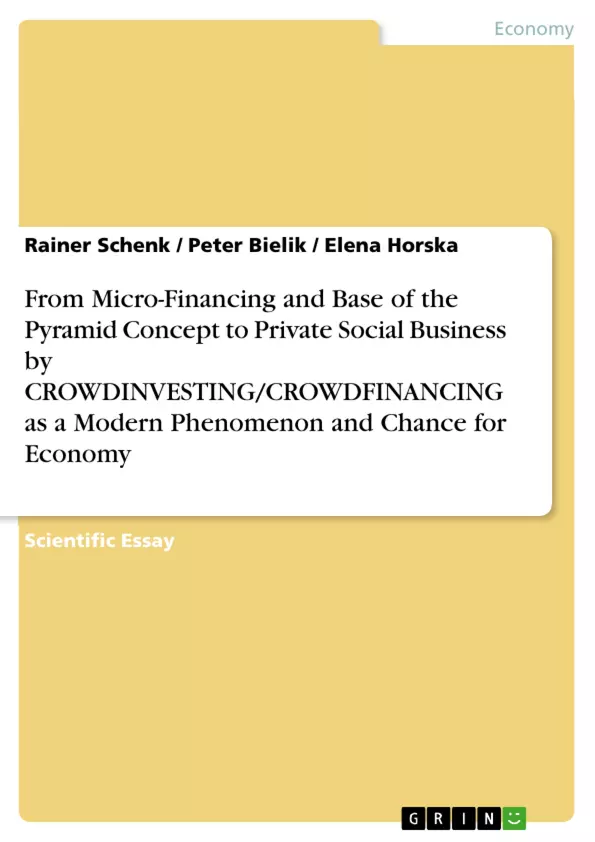Der Beseitigung von Armut in den Entwicklungsländern und Schwellenländern sollte zukünftig mehr Beduetung beigemessen werden. Die Beseitigung der Armut sollte strukturiert unter Einsatz moderner Konzepte und Ideen erfolgen. Das Base of Pyramid Konzept von Prahalad ist eine gute Basis hierfür. Der einseitige Einsatz von sogenannten Mikrokrediten hat bisher keine nachhaltigen Erfolge bei der Beseitigung von Armut gebracht.Rund 4 Milliarden Mesnchen in unterschiedlichen Ländern dieser Erde werden als "arm" klassifiziert. Das sind über 50% der Weltbevölkerung. Die finanzielle Unterstützung der Armen soll nicht einseitig Konsum zugunsten MNC (Mulitnational Companies) und deren Profit unterstützen, sondern vielmehr die Integration der Armen in die Wertschöpfungskette ermöglichen. Unternehmen können mit CSR Projekten Arme als "new base of pyramid entreprenieurs" fördern und in deren Prozesse mit einbinden. CRS kann mit crowdfunding und Crowdinvesting bzw. Crowdbankung kombiniert werden, um somit eine Optimierung der Beseitigung der Armut zu ermöglichen. Das bisherige System der Mikrokredite hat weitestgehend versagt und zu einer neuen Finanzierungsblase geführt. Damit hat einmal mehr der typische Finanzsektor ein Stück seiner Existenzberechtigung eingebüßt. Wie das Base dieser Aufsatz.
Inhaltsverzeichnis (Table of Contents)
- Abstract
- Introduction
- The meaning of “Base of the Pyramid”
- Micro-financing and the Base of the Pyramid Concept
- Crowdinvesting/Crowdfunding as a Modern Phenomenon and Chance for Economy
Zielsetzung und Themenschwerpunkte (Objectives and Key Themes)
This essay examines the situation of impoverished populations in developing and emerging countries and explores approaches for addressing poverty and promoting prosperity in these regions. The work focuses on the potential of innovative financial tools, such as micro-financing and crowdinvesting, to empower individuals and contribute to sustainable economic growth. Key themes explored in this essay include:- The Base of the Pyramid (BOP) Concept and its implications for development
- The role of micro-financing in poverty reduction and its limitations
- Crowdinvesting/Crowdfunding as a new approach to financing enterprises, particularly in developing countries
- The potential for crowdinvesting as a sustainable instrument for financing startups and small and medium enterprises (SMEs)
- The integration of social and economic objectives in business models designed for the BoP market.
Zusammenfassung der Kapitel (Chapter Summaries)
- Abstract: This section outlines the primary argument of the essay, highlighting the challenges of poverty in developing countries and the potential of crowdinvesting as a modern financing mechanism. The abstract emphasizes the need for education, property rights, and corporate social responsibility (CSR) policies to complement financial solutions.
- Introduction: The introduction discusses the persistent problem of poverty globally, despite decades of efforts to eradicate it. It introduces the concept of the Base of the Pyramid (BOP) as a framework for understanding poverty and its potential for addressing it through innovative business models. The chapter further explores the limitations of traditional micro-financing and presents crowdinvesting/crowdfunding as a possible alternative.
- The meaning of “Base of the Pyramid”: This chapter defines the concept of the BoP, highlighting its size and economic potential. It examines the challenges and opportunities associated with targeting the BoP market, emphasizing the need for cultural sensitivity and a focus on improving living conditions.
- Micro-financing and the Base of the Pyramid Concept: This chapter explores the application of micro-financing within the BoP framework. It discusses the limitations of micro-financing, including issues of repayment rates and potential for exploitation. The chapter also examines the potential for alternative financial solutions that integrate social and economic objectives.
Schlüsselwörter (Keywords)
The core keywords and focus topics of this work include: crowdinvesting, micro-financing, developing countries, microcredit, Base of the Pyramid (BOP) concept, Private Social Business (PSB), social entrepreneurship, sustainable development, and global poverty. This essay delves into the intersection of financial innovation, social responsibility, and economic development in the context of emerging markets.- Arbeit zitieren
- Rainer Schenk (Autor:in), Peter Bielik (Autor:in), Elena Horska (Autor:in), 2013, From Micro-Financing and Base of the Pyramid Concept to Private Social Business by CROWDINVESTING/CROWDFINANCING as a Modern Phenomenon and Chance for Economy, München, GRIN Verlag, https://www.grin.com/document/212659



